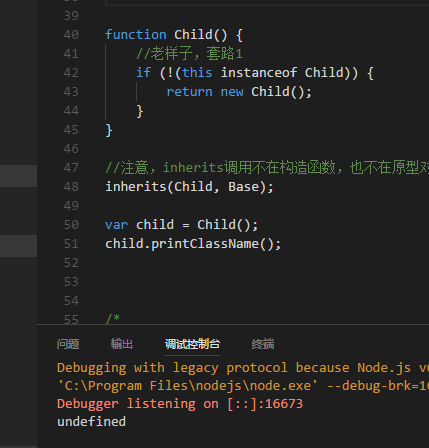JS学习:nodejs中的类定义和继承的套路
javascript是一门极其灵活的语言。
灵活到你无法忍受!
我个人喜欢强类型的语言,例如c/c++,c#等。
但是js代表着未来,所以需要学习。
js中类定义以及继承有n多种方式,现在来学习一下nodejs类定义以及继承的固定套路。
套路1. 在构造函数(constructor)中总是使用instanceof操作符:
function Base() {
if (!(this instanceof Base)) {
return new Base();
}
}上述代码的含义就是: 如果Base这个函数调用时没有使用new操作符,则会自动调用new操作符,返回Base的实例
套路2. 所有成员变量定义在构造函数(constructor)中
function Base() {
if (!(this instanceof Base)) {
return new Base();
}
//开始成员变量定义
this.className = "Base";
}套路3. 所有的成员方法以函数表达式方式定义在原型(prototype)中【为什么要这样,其原因在套路4中的inherits源码注释中】
Base.prototype.printClassName = function(){
console.log(this.className);
}调用如下:
var base = Base(); //不使用new操作符,直接进行函数调用,自动调用new操作符
console.log(base.className);
base.printClassName();套路4. 使用util.inherits(子类,父类)进行原型(prototype)继承
先来看一下inherits的源码:
var inherits = function(ctor, superCtor) {
//严格相等测试:undefined/null
//子类构造函数必须存在
if (ctor === undefined || ctor === null)
throw new TypeError('The constructor to "inherits" must not be ' +
'null or undefined');
//严格相等测试:undefined/null
//父类构造函数必须存在
if (superCtor === undefined || superCtor === null)
throw new TypeError('The super constructor to "inherits" must not ' +
'be null or undefined');
//要点: 如果要继承的话,父类必须要有prototype对象
//这也是为什么将所有成员方法都定义在prototype对象中!!!
if (superCtor.prototype === undefined)
throw new TypeError('The super constructor to "inherits" must ' +
'have a prototype');
//让子类构造函数对象增加一个super_指针,指向父类,这样就形成继承链
ctor.super_ = superCtor;
//调用Object.setPrototypeOf(子类的prototype,父类的prototype)
Object.setPrototypeOf(ctor.prototype, superCtor.prototype);
};Object.setPrototypeOf : 该链接可以了解一下setPrototypeOf方法,非常简单,其Polyfill如下:
// 仅适用于Chrome和FireFox,在IE中不工作:
Object.setPrototypeOf = Object.setPrototypeOf || function (obj, proto) {
obj.__proto__ = proto;
return obj;
}我们来测试一下继承。
先定义子类
function Child() {
//老样子,套路1
if (!(this instanceof Child)) {
return new Child();
}
}然后根据套路4, 调用inherits函数进行原型继承
//注意,inherits调用不在构造函数,也不在原型对象,而是全局调用
inherits(Child, Base);最后我们调用一下child的printClassName方法,该方法在基类原型对象中实现。
出现错误,child.printClassName()后输出undefined!
为什么呢?
套路5. 子类的构造函数中使用 父类.call(this),实现父类构造函数中的成员变量继承
function Child() {
//老样子,套路1
if (!(this instanceof Child)) {
return new Child();
}
//增加这句话,在调用printClassName就能正常的输出Base字符串
Base.call(this);
//如果要更新基类的成员变量,请在Base.call(this)之后!
this._className = "Child"; //调用printClassName就能正常的输出Child字符串
}由此可见,nodejs中的继承需要:
在构造函数中调用 父类.call(this),实现父类成员变量的继承
全局调用inherits(子类,父类) 进行父类成员函数的继承
点击查看更多内容
为 TA 点赞
评论
共同学习,写下你的评论
评论加载中...
作者其他优质文章
正在加载中
感谢您的支持,我会继续努力的~
扫码打赏,你说多少就多少
赞赏金额会直接到老师账户
支付方式
打开微信扫一扫,即可进行扫码打赏哦






